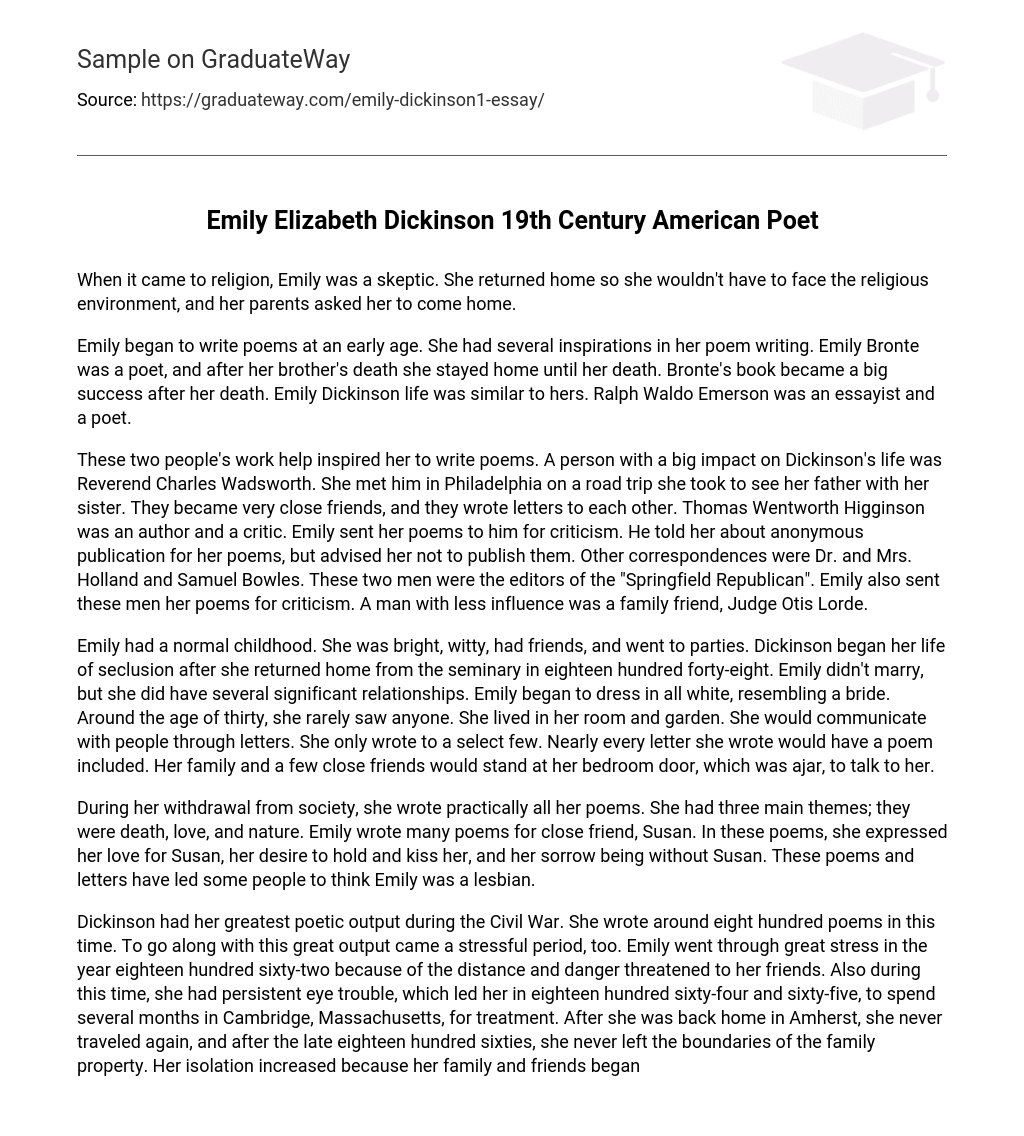When it came to religion, Emily was a skeptic. She returned home so she wouldn’t have to face the religious environment, and her parents asked her to come home.
Emily began to write poems at an early age. She had several inspirations in her poem writing. Emily Bronte was a poet, and after her brother’s death she stayed home until her death. Bronte’s book became a big success after her death. Emily Dickinson life was similar to hers. Ralph Waldo Emerson was an essayist and a poet.
These two people’s work help inspired her to write poems. A person with a big impact on Dickinson’s life was Reverend Charles Wadsworth. She met him in Philadelphia on a road trip she took to see her father with her sister. They became very close friends, and they wrote letters to each other. Thomas Wentworth Higginson was an author and a critic. Emily sent her poems to him for criticism. He told her about anonymous publication for her poems, but advised her not to publish them. Other correspondences were Dr. and Mrs. Holland and Samuel Bowles. These two men were the editors of the “Springfield Republican”. Emily also sent these men her poems for criticism. A man with less influence was a family friend, Judge Otis Lorde.
Emily had a normal childhood. She was bright, witty, had friends, and went to parties. Dickinson began her life of seclusion after she returned home from the seminary in eighteen hundred forty-eight. Emily didn’t marry, but she did have several significant relationships. Emily began to dress in all white, resembling a bride. Around the age of thirty, she rarely saw anyone. She lived in her room and garden. She would communicate with people through letters. She only wrote to a select few. Nearly every letter she wrote would have a poem included. Her family and a few close friends would stand at her bedroom door, which was ajar, to talk to her.
During her withdrawal from society, she wrote practically all her poems. She had three main themes; they were death, love, and nature. Emily wrote many poems for close friend, Susan. In these poems, she expressed her love for Susan, her desire to hold and kiss her, and her sorrow being without Susan. These poems and letters have led some people to think Emily was a lesbian.
Dickinson had her greatest poetic output during the Civil War. She wrote around eight hundred poems in this time. To go along with this great output came a stressful period, too. Emily went through great stress in the year eighteen hundred sixty-two because of the distance and danger threatened to her friends. Also during this time, she had persistent eye trouble, which led her in eighteen hundred sixty-four and sixty-five, to spend several months in Cambridge, Massachusetts, for treatment. After she was back home in Amherst, she never traveled again, and after the late eighteen hundred sixties, she never left the boundaries of the family property. Her isolation increased because her family and friends began to die. This is one of her well known poems.
“Because I could not stop for Death,
The carriage held but just ourselves
We slowly drove, he knew no haste,
We passed the school where children played,
Their lessons scarcely done;
We passed the fields of grazing grain,
We passed the setting sun.
We paused before a house that seemed
A swelling of the ground;
The roof was scarcely visible,
The cornice but a mound.
Since then ‘t is centuries; but each
Feels shorter than the day
I first surmised the horses’ heads
Were toward eternity.”
Emily wrote between one thousand seven hundred and two thousand poems. Almost all of her poems were untitled. Somewhere between seven and ten were published in her lifetime. The reason so few were published was because her poetry was ahead of its time. Emily’s poems were different from what the people were used to at this time. She had a great talent for writing poems, but it was not acknowledge until after her death. Here is another one of her great poems.
Emily took her last breath on May fifteenth, eighteen hundred eighty- six. She died of a kidney dysfunction. Her sister, Lavinia, found some of her poems in a hand sewn booklet in her room. Lavinia wanted to get all of her sister’s poems published. She took them to a family friend, Mrs. Mabel Loomis Todd, and Thomas Wentworth Higginson to get the poems published. Since her poems were untitled, they used the first couple of words or the first line to title the poem. They published one hundred fifteen of her poems in eighteen hundred ninety. Later they published a second group in eighteen hundred ninety-one, which was one hundred sixty-six poems. Then in eighteen hundred ninety-six, Mrs. Todd edited a third series. These two revised all of Emily’s poems; they smoothed the rhymes and meter. When Dickinson’s niece, Martha Dickinson Bianchi, started to publish the poems, she didn’t edit the poems as much. Emily Elizabeth Dickinson lived fifty-six years and half those years she lived in seclusion. She saw the world in a different view, and she showed it in her poetry. Emily has been ranked with the America’s finest.





